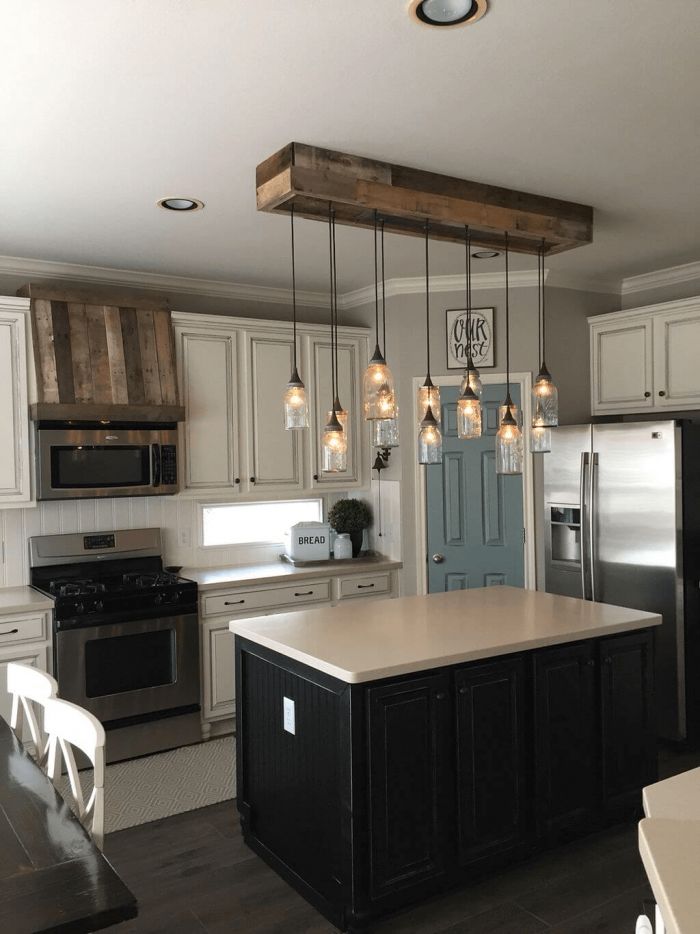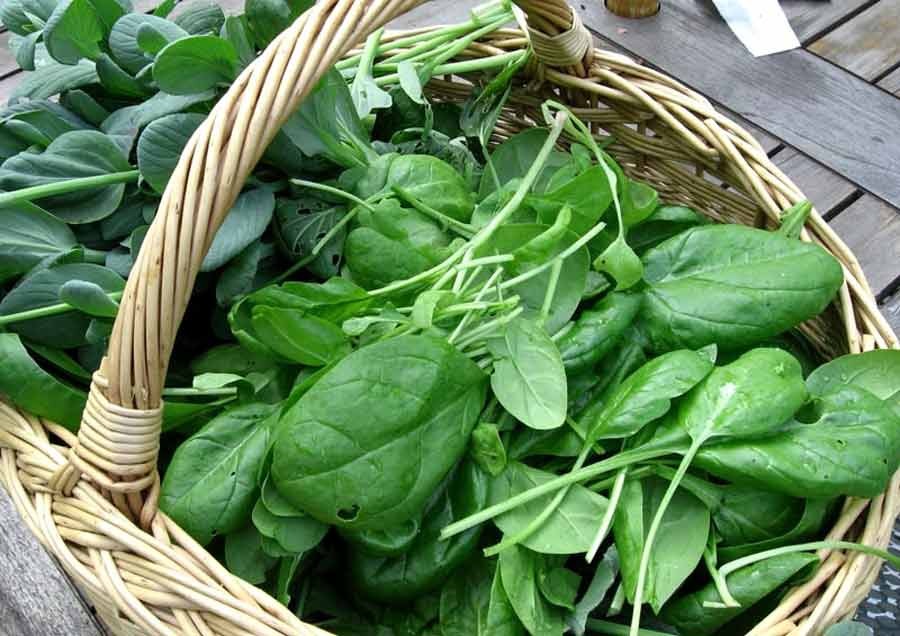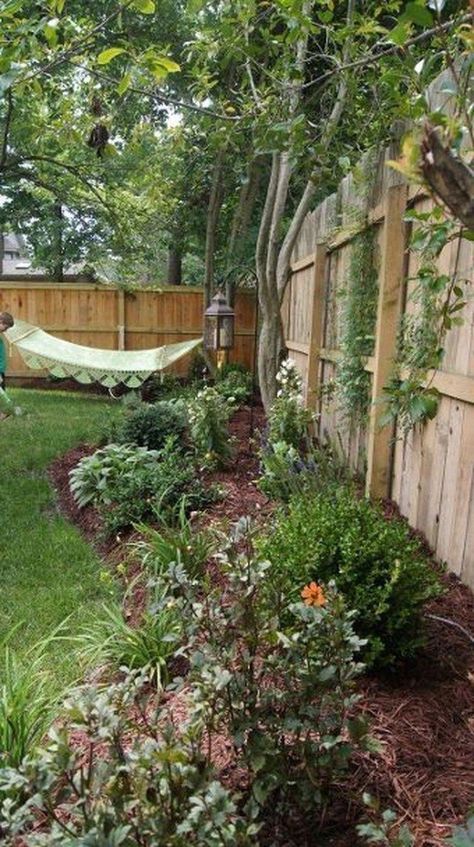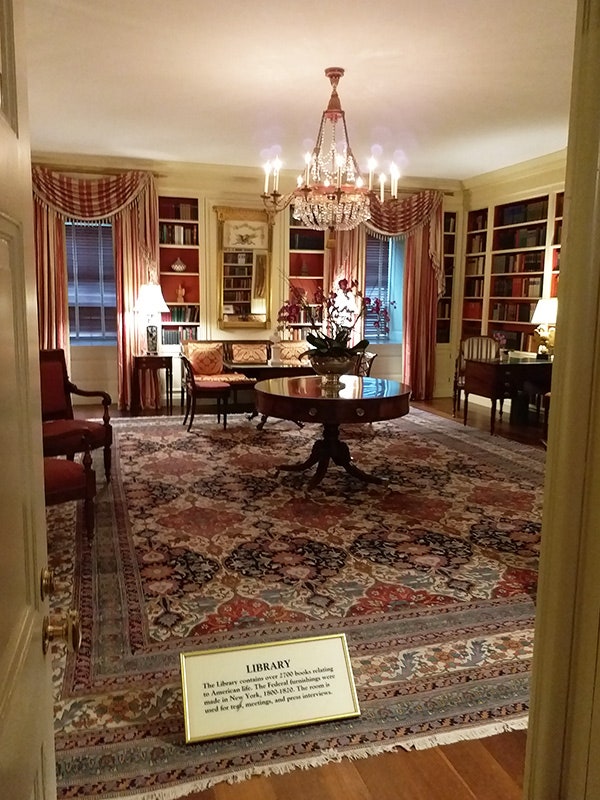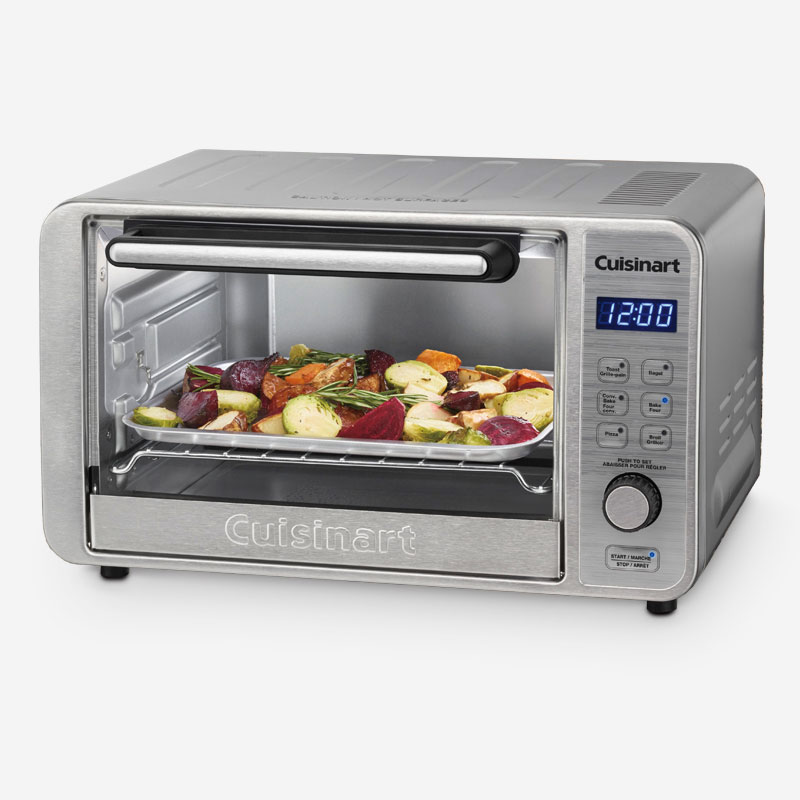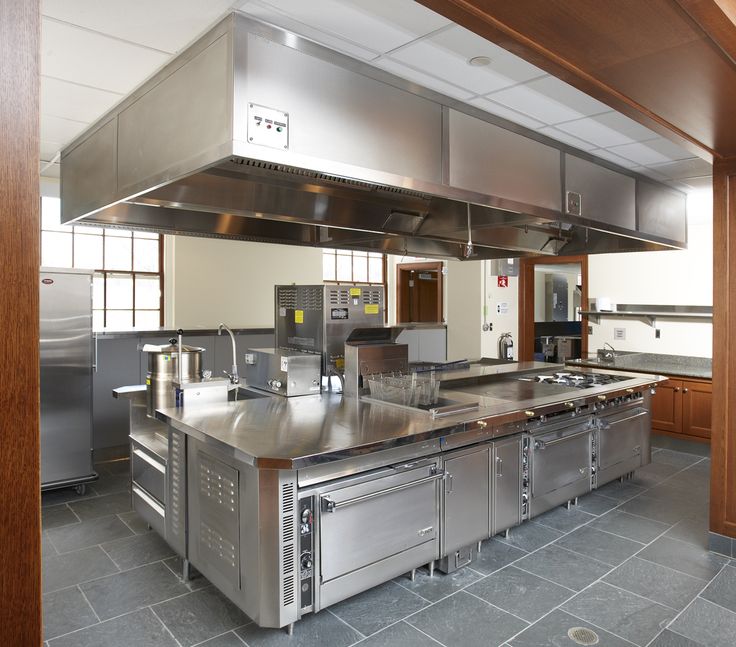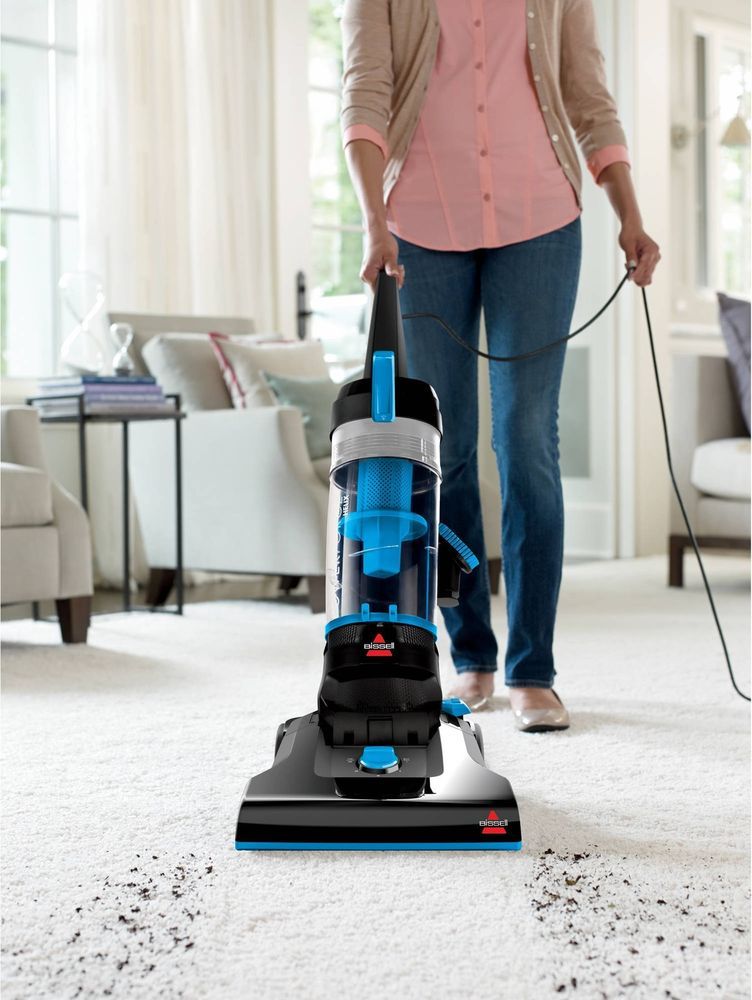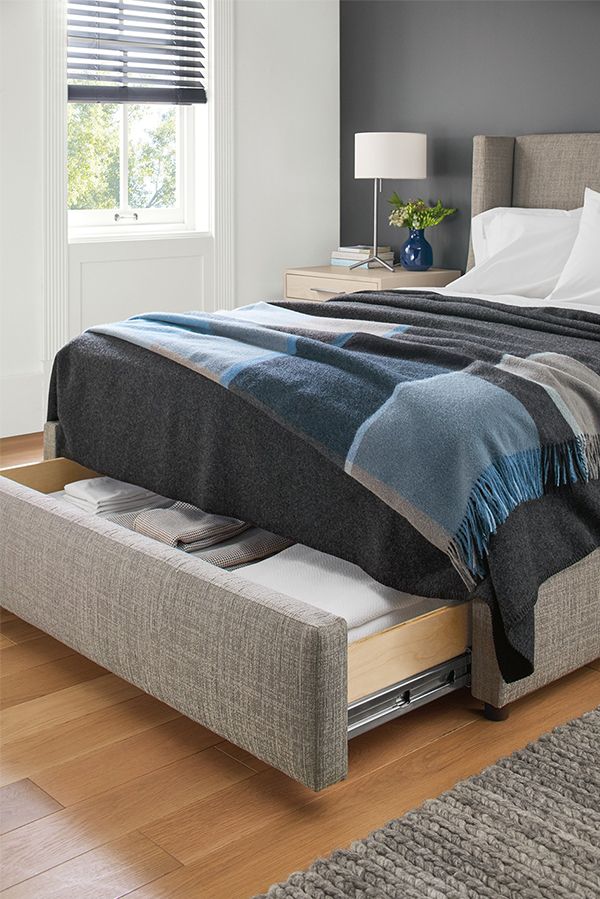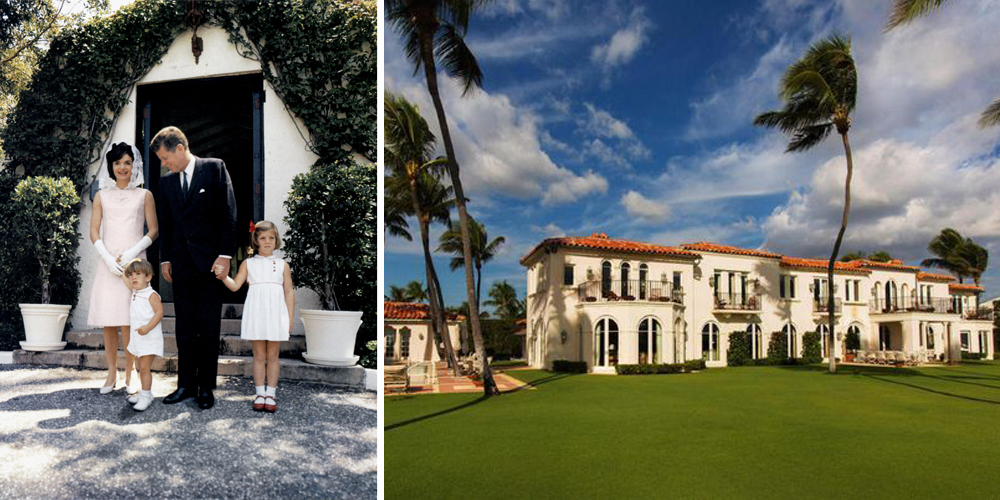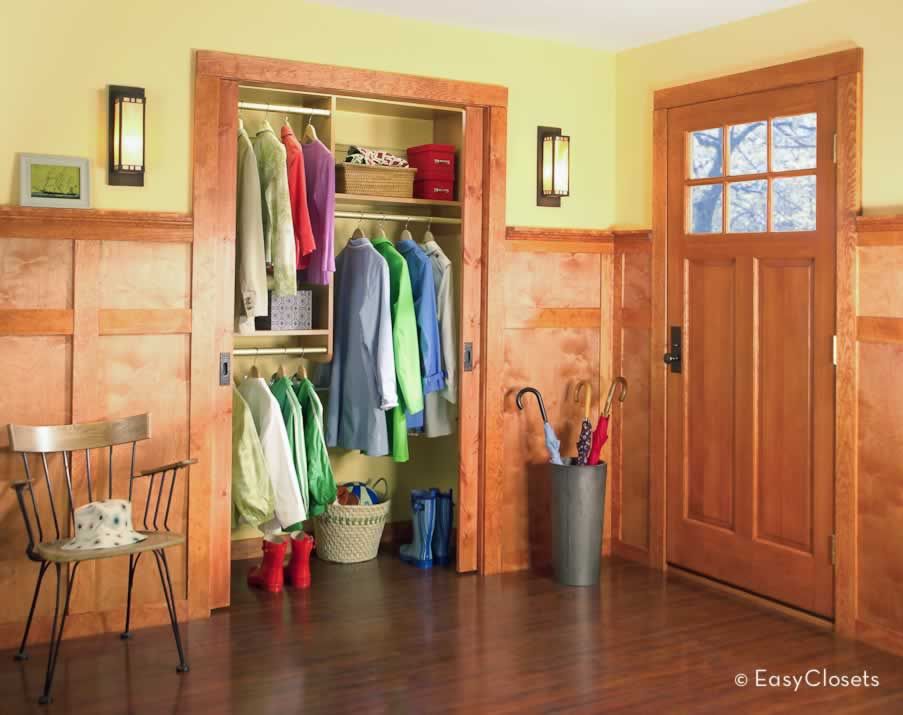Small trees that grow in pots
Constrained by The City? Try Container Trees
When you were little, did you have a tree house? Did you pick apples in your uncle’s orchard? Did you build a secret fort under a pine tree, digging into the soft pine needles on the ground? Even if you’re done playing with trees, you still know trees are amazing. They give us shade, they improve air quality, they’re beautiful to look at. And fortunately, you don’t need a huge yard, or any yard at all to plant a tree. Even a city stoop, a backyard deck, or small terrace has room for a small tree in a container. Read up!
Which Tree?
Planting a container tree is a little different from planting a tree in the ground. It’s not more difficult, there are just a few extra things to think about. First, choose a tree that adapts well to container growing; small trees are better choices. They’re easier to move and easier to plant. (Root balls can be heavy, especially if they get wet.) Second, choose a slow-growing tree so you won’t have to re-pot often. Fast growing trees like arborvitae might need re-potting every other year, while slow growers like mugo pines can go four or five years before they need repotting. Finally, think about whether you’d like a tree that flowers and fruits, one that’s grown for decorative foliage, or one that will be evergreen year round. Flowers and fruits add extra beauty and interest, but you may find yourself cleaning up after fallen fruit. Deciduous trees have leaves of interesting shapes, sizes, and colors, while evergreens provide year round greenery.
1. Purple Leaf Plum (zones 4 - 9)
2. Japanese maple (zones 5 - 9)
3. Paperbark Maple (zones 4 - 8)
4. Smoketree (zones 4 - 8)
5. Serviceberry (zones 3 - 9; depending on the variety)
6.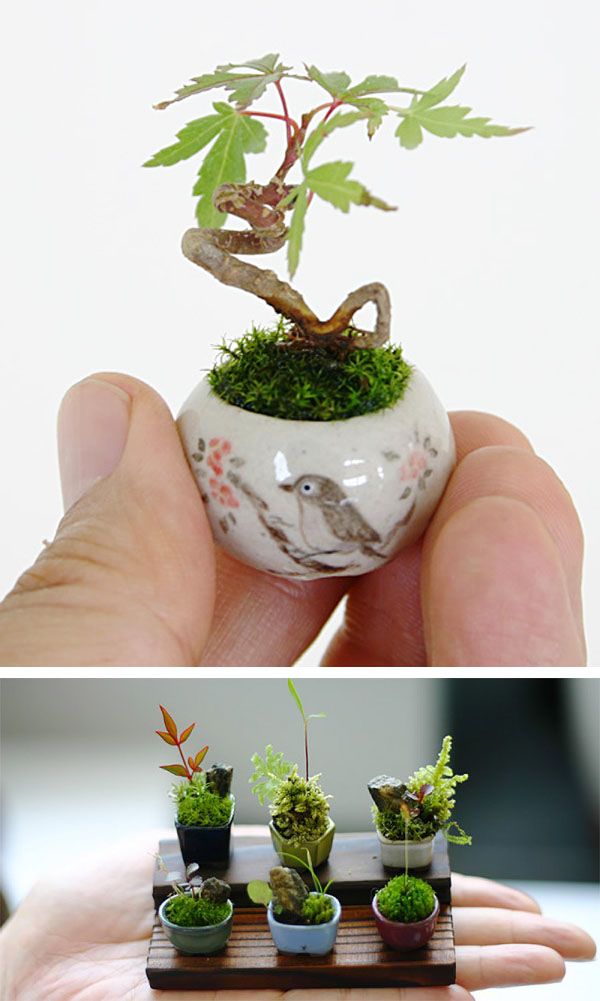 Crepe Myrtle (zones 7 - 11; some new hybrids are hardy to zone 6 or 5, but generally not in containers)
Crepe Myrtle (zones 7 - 11; some new hybrids are hardy to zone 6 or 5, but generally not in containers)
7. Kousa Dogwood (zones 5 - 8)
8. Crabapple (zones 4 - 8)
9. Dwarf Alberta Spruce (zones 2 - 8)
10. Mugo Pine (zones 2 - 8)
Trees in containers have less soil surrounding their roots than trees planted in the ground. This makes them more vulnerable to cold, so choose a tree that can stand up to your winter growing conditions. To do that, you’ll need to know your USDA hardiness zone; the colder your winters are, the lower the number of your hardiness zone.
PRO TIP: When you find your zone, subtract one zone for planting in a container, and another for every ten floors above street level where the tree will grow. For example, if you live in Zone 7 and you’re planting a tree at street level, choose a tree that’s hardy to Zone 6. If your balcony is on the 12th floor, choose a tree that’s hardy to Zone 5. This will make up for having less soil insulating the root ball.
For example, if you live in Zone 7 and you’re planting a tree at street level, choose a tree that’s hardy to Zone 6. If your balcony is on the 12th floor, choose a tree that’s hardy to Zone 5. This will make up for having less soil insulating the root ball.
How big does your container need to be? To choose your container size, first measure the diameter of your root ball. You should surround the root ball with 6 – 8 inches of insulating soil on every side, which means you’ll need a container that’s 12 – 16 inches larger in diameter than your tree’s root ball.
Do winter temperatures get below freezing where you live? If so, choose a frost resistant container. An unglazed clay pot will absorb water and may crack as the water in the clay freezes and thaws. Fiberglass, metal, and wood are all sturdy choices.
Does your container have drainage holes in the bottom? Most pots come with one drainage hole, but for a tree in a large container you should add a few more. It’s important that excess water be able to drain from the container so the roots of your tree don’t rot. To improve drainage, drill one-inch holes at six-inch intervals in the bottom of your container, then elevate your container a few inches off the ground (or deck). You can use small pieces of pressure treated lumber or special pot feet.
It’s important that excess water be able to drain from the container so the roots of your tree don’t rot. To improve drainage, drill one-inch holes at six-inch intervals in the bottom of your container, then elevate your container a few inches off the ground (or deck). You can use small pieces of pressure treated lumber or special pot feet.
PRO TIP: Once you’ve prepped your pot, cut a piece of screen or landscape cloth to cover the holes you’ve just drilled. After all, we don’t want any precious, rich soil leaking out the holes.
How to Plant: Step by StepFall and spring are generally the best seasons for tree planting, because temperatures are moderate. Try to avoid transplanting when temperatures are above 80F; high temperatures will stress the tree. In fall, aim to plant 6 - 8 weeks before the first frost, so roots have time to establish themselves before the ground freezes.
Now let’s look at your tree. Slide it out of its pot so you can examine the roots.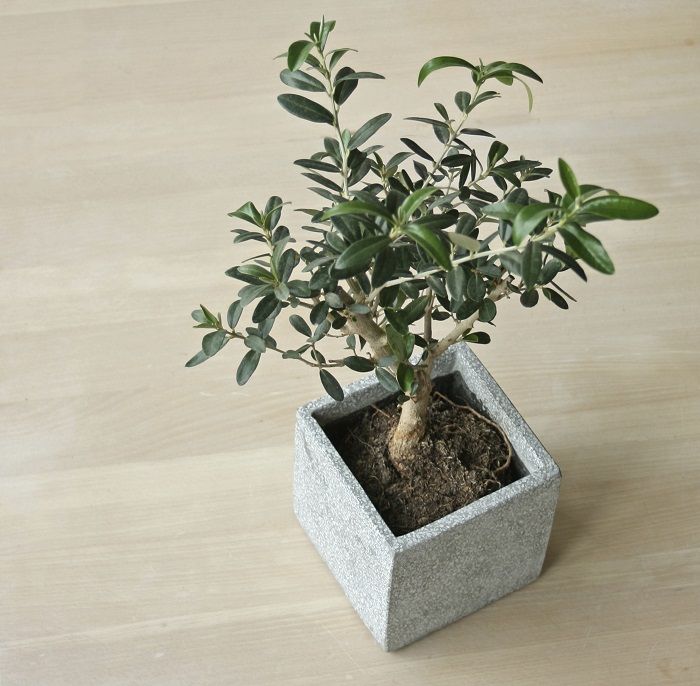 (It’s ok to cut away the container if the tree feels stuck, but try to keep the roots intact). If the roots are tightly stuck together in the area circling the root ball, tug them apart so they radiate out from the trunk. Also, check the trunk of the tree where it meets the soil. Do you see a slight flare? If not, use your hands to pull soil away from the trunk until you expose the flare. This tells you where the soil level should be. Burying the flare can lead to root rot.
(It’s ok to cut away the container if the tree feels stuck, but try to keep the roots intact). If the roots are tightly stuck together in the area circling the root ball, tug them apart so they radiate out from the trunk. Also, check the trunk of the tree where it meets the soil. Do you see a slight flare? If not, use your hands to pull soil away from the trunk until you expose the flare. This tells you where the soil level should be. Burying the flare can lead to root rot.
Before you move the tree into its new container, measure the height of the root ball. Let’s say yours is 16 inches tall (from trunk flare to the bottom of the roots) and your container is 24 inches tall. 24 – 16 = 8. Leaving two inches of space at the top of the pot (so you don’t splash and spill each time you water) means you’ll need to make up 6 inches of height, so that’s how much soil you’ll add to the bottom of your pot before planting. Be sure to press the soil down firmly, so the weight of the tree doesn’t make it sink in the pot.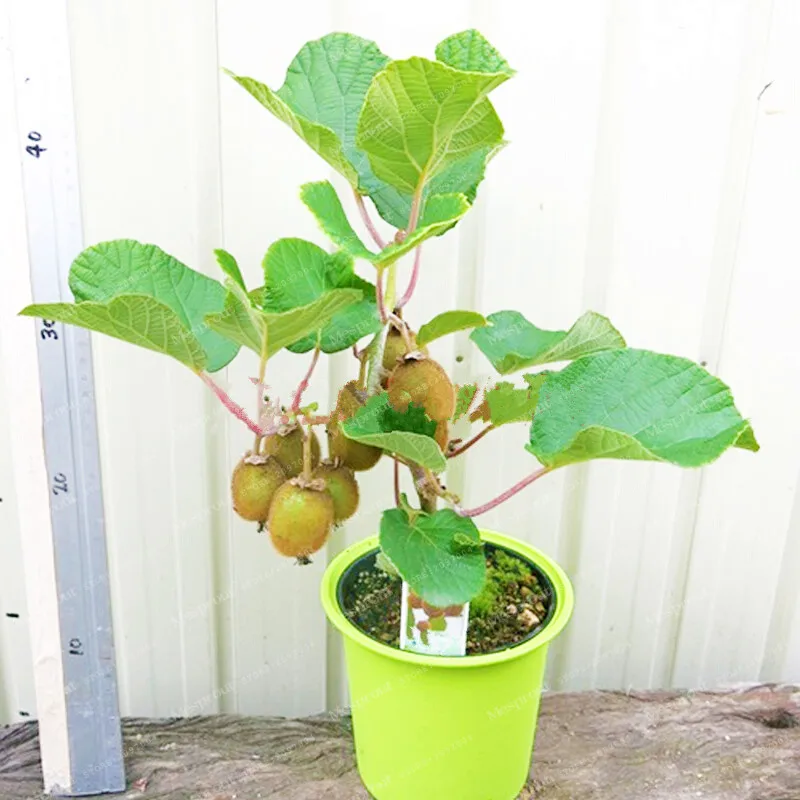
You should never use yard or garden soil for a container tree. Not only might it contain pathogens (including insects, bacteria, and fungal spores), but it is also very heavy. For drought tolerant trees, like smoketree, crabapples, and purple leaf plum, try a fast draining mix (like Opus Mix#3). For trees that appreciate more consistent moisture, like Japanese maple, try a moisture retentive mix (like Opus Mix#2). Opus Mix#1 is a good choice for most other trees, providing good drainage and moderate water retention.
Lift the tree into the center of the pot and hold it steady while you add soil all the way around the root ball. (It might be handy to have a friend help with this part.) Use your hands or a two by four to tamp the soil firmly into place. When you’ve added enough soil to be level with the top of the root ball, it’s time to start watering. You’ll do this in stages, each time watering until water reaches almost to the top of the pot.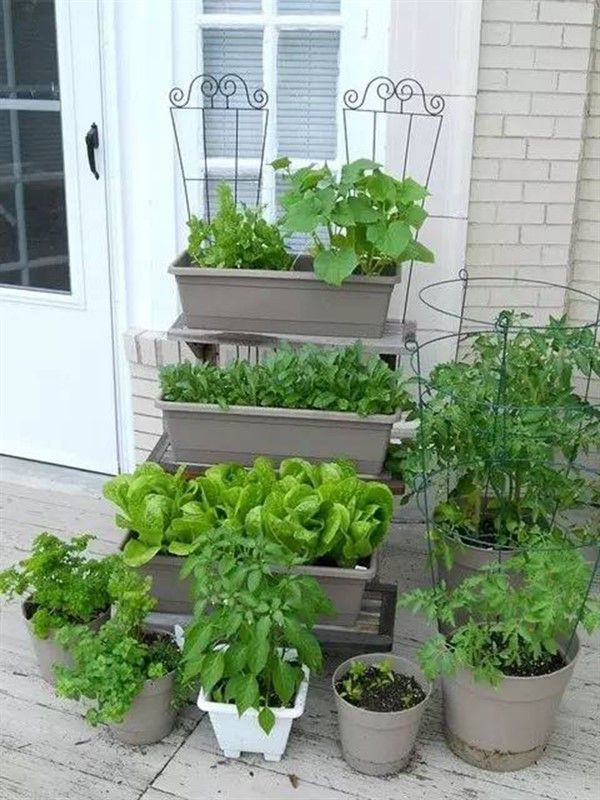 Let it be absorbed by the soil, then check the soil level. You may need to add more as the tree settles into place. Continue to water at intervals, until water flows out the drainage holes in the bottom of the pot. This means the potting soil is fully saturated.
Let it be absorbed by the soil, then check the soil level. You may need to add more as the tree settles into place. Continue to water at intervals, until water flows out the drainage holes in the bottom of the pot. This means the potting soil is fully saturated.
Congratulations, you’ve planted a container tree! Every home feels homier with a tree by the front door. A tree says someone lives there. A tree says someone cares.
SaveSave
Best trees to grow in pots: 15 beautiful compact varieties
(Image credit: Leigh Clapp)
The best trees to grow in pots can add much needed interest to patios, courtyards and other areas of your back yard.
With both deciduous and evergreen options, offering various leaf color, fruit and flowers through the seasons, potted trees are versatile container gardening ideas.
Growing pots in trees is a way to zone a secluded seating or dining area as a patio idea, flowering trees can add color and scent, while citrus or olive trees are ideal if you want to create a Mediterranean-style garden.
One of the big advantages is that you can grow tree species that wouldn't usually suit the growing conditions in your hardiness zone as the best trees to grow in pots can be moved indoors in colder months.
The best trees to grow in pots
Many different trees can thrive in pots, so look beyond the local garden center for inspiration. You could choose one of the best indoor trees that you move outdoors in warmer months to surround yourself with nature year round.
'There are many types of trees you can grow in pots and containers,' says small space gardening expert Emilly Barbosa Fernandes of Housegrail . 'They instantly brighten up any garden, and can become the main focal point.'
If you want a low-maintenance planting scheme, then the best trees to grow in pots must be compatible with your local climate, and require minimal pruning. An advantage of planting trees in pots is that you can control their soil type – perhaps growing an acid-loving tree in a chalky soil, or creating free-draining conditions in a garden with heavy clay soil.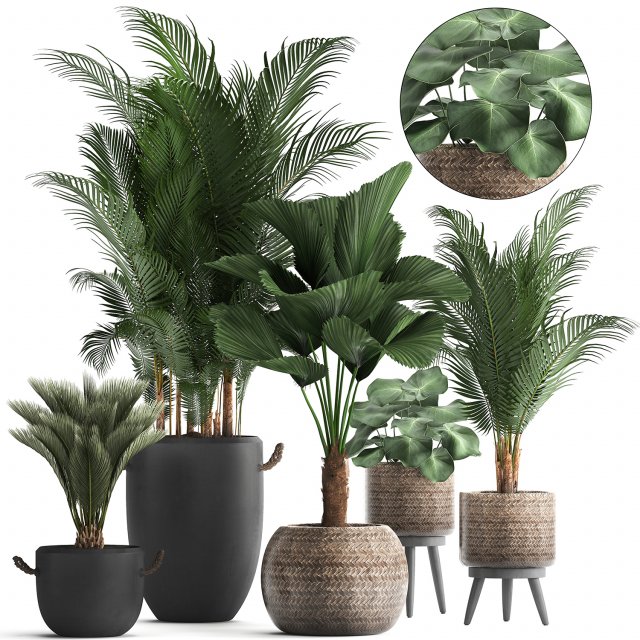
Consider where you want the tree to be positioned in your garden, as whether it will sit in full sun or receive some shade will be a factor in which varieties will be suitable.
It's important to look at the maximum size of a tree species, and how many years it will take to reach maturity. Some trees are suited to pots for their whole life, while other slow-growing varieties can have a long pot life before needing to be eventually planted in the ground as part of your flower bed ideas.
Trees have hungry, thirsty roots, so container size is also key. Ensure you invest in a pot that's big enough for your chosen tree to flourish.
Remember that a tree planted in a pot will dry out more quickly than in the ground, and the smaller the pot size, the more often you will have to water it.
1. Peach tree
(Image credit: Getty Images)
Enjoy a delicious home harvest of fruit by growing a peach tree in a container. These are among the best fruit trees to grow, and ideal for trees to grow in pots, particularly as you can move the container to the sunniest and warmest positions throughout the year.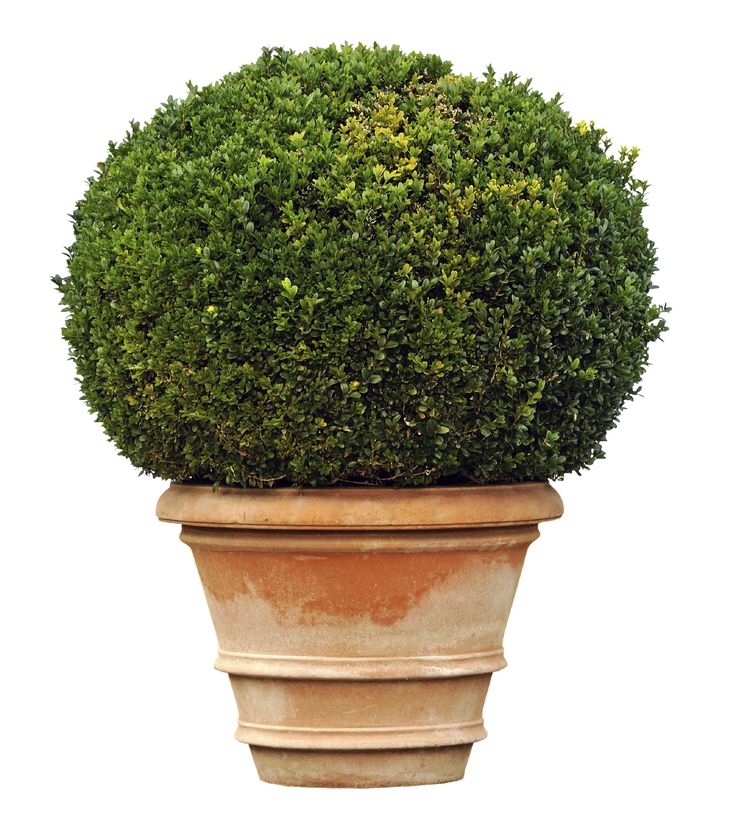
You will need a fairly large container for growing a peach tree – although not so large that you can not easily move it when required. Good drainage is important, so either add some crocs or stones to the bottom of a container, or raise it up on pot feet to aid drainage.
'You will need to water peach trees grown in pots almost every day in the growing season, and repot them every few years' explains Guy Barter, chief horticulturist at the RHS .
2. Crab apple tree
(Image credit: Getty Images)
Producing lovely pink blossom in spring, followed by their ornamental fruits in fall, crab apples are among the best trees to grow in pots.
When planting crab apples in containers, use a pot that is approximately 12-15in. (30-40cm), in a good quality and free draining loam based compost, explain the experts at Pomona Fruits .
Keep them well watered in the first growing season, watering them daily in warmer weather. They are also among the best trees for autumn color.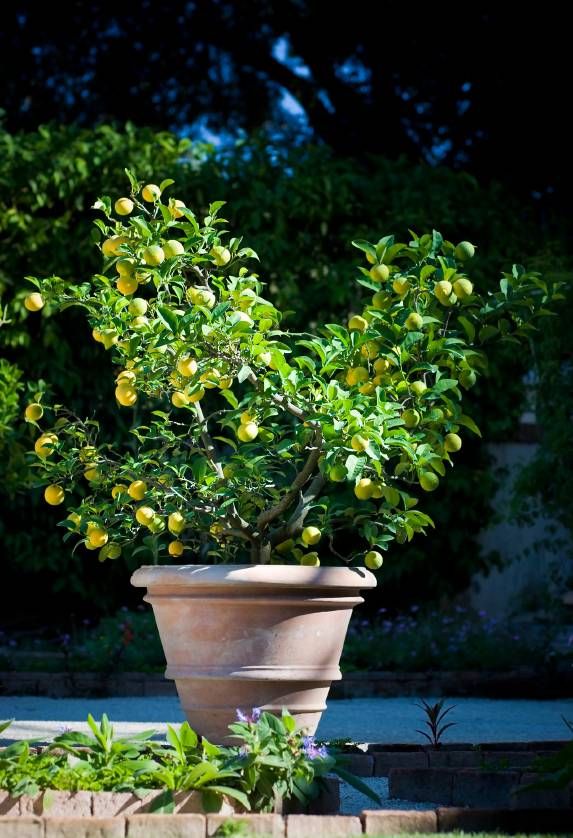
3. Amelanchier
(Image credit: Leigh Clapp)
A small, compact deciduous tree, amelanchier – known by a number of other names including juneberry, shadbush and sarvisberry – offers interest through the seasons. It produces lovely starry white flowers in spring, red and purple berries in summer through to fall, and its bronze tinged young leaves turn through green to the fiery colors of orange and red, making this undoubtedly one of the best trees to grow in pots .
Amelanchier prefers a spot in full sun, so move the container to the best spot throughout the year. Plant bare root trees for the most economical option, in ericaceous compost in a large pot.
4. Japanese maple tree
(Image credit: Ian West / Alamy Stock Photo)
Japanese maples trees – or acer palmatum – are ideal for smaller gardens, as they are slow growing and require minimal pruning or training. They also offer lovely fall color.
‘With a variety of showy cascades in foliage and colors ranging from vibrant greens to deep blood reds, this is a showcase tree for container growing,’ says Tammy Sons, owner of Tennessee Nursery .
‘Japanese maple trees do not grow to extreme heights, seldom reaching over 15 feet. My favorite varieties are 'Crimson Queen' and 'Bloodgood', with their added attribute of spectacular fall foliage.’
Meanwhile, Lisa Tadewaldt, arborist and owner of Urban Forest Pro , particularly favors the dwarf maple 'Sharp's Pygmy'. ‘They can live in a pot for hundreds of years,' she says. 'You can ignore them or pamper them – either way they always look great. This is a favorite of serious bonsai artists, and what I personally have on my deck in pots.’
Position Japanese maples in a cool spot that receives some shade during the hottest part of the day, and water regularly in the summer. They are perfect to include for Japanese garden ideas.
5. Lemon tree
(Image credit: Future / Mark Bolton)
‘I always think there is something very romantic about a lemon tree growing in a pot,’ says Aaron Bertelsen, author of Grow Fruit & Vegetables in Pots . ‘Perhaps it is the way the scent of the blossom fills a room, or the knowledge that rich people in the past would build dedicated lemon houses to shelter their highly prized trees.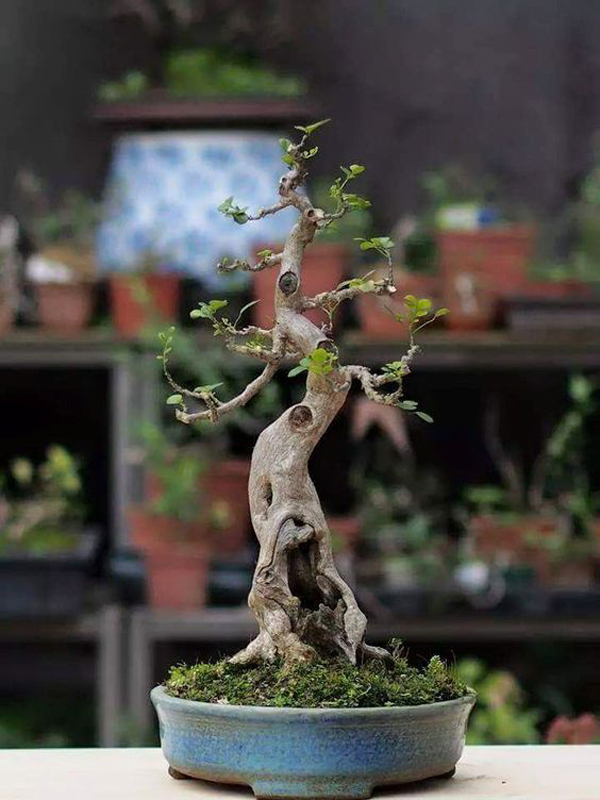 ’
’
While lemon trees make fantastic house plants during the winter, they can grow happily outdoors during the spring and summer. This is why planting them in pots is the best solution, so you can bring them indoors in frosty weather.
You can even learn how to grow lemon from seed, to surround yourself with these uplifting trees.
‘Lemons are hungry plants, so make sure you use a good, soil-based compost, adding some grit or sharp sand to improve drainage,’ adds Bertelsen, who recommends the Meyer variety as it flowers throughout the year.
Make sure you understand how to prune lemon trees to get the best out of them, and let them dry out between waterings.
6. Dwarf conifers
(Image credit: Leigh Clapp)
Larger conifers are some of the best trees for privacy and screening in a backyard, but there are a number of smaller species that are perfect for pots.
Some recommended conifers to consider are dwarf varieties of cypress trees, yew trees, mountain pines, and Chinese juniper.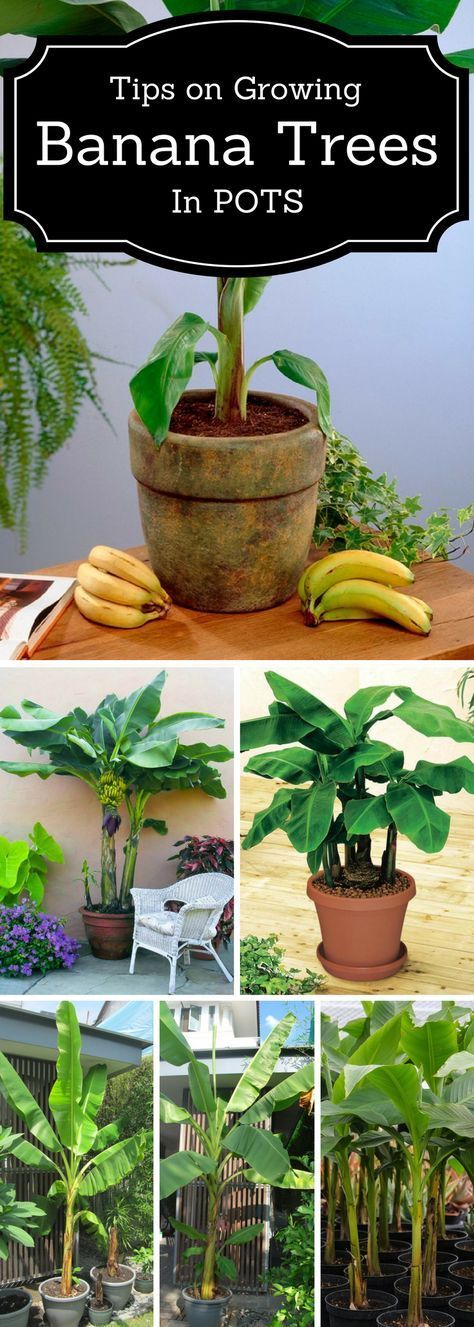
‘They are not top-heavy and have an equal branch structure from the central leader to the top,’ says Sons.
‘Evergreen conifers also offer year-round beauty and they can successfully be trimmed back in order for them to not overwhelm the container.’
7. Crepe Myrtle
(Image credit: Biosphoto / Alamy Stock Photo)
Crepe myrtle – or crape myrtle – is a striking tree that offers year-round interest, and grows very well in pots.
‘This beautiful tree has large trumpet-shaped flowers that often have an orange tint to them,’ says Lindsey Hyland, founder of Urban Organic Yield . 'Crape myrtles also have good fall color, with attractive peeling bark. I love how the branches are always thick enough to handle being in pots.’
Choose from flowers of white, pink or purple, which bloom from late spring through summer. Some varieties flower until the first frost in fall.
Crepe myrtle trees need full sun to thrive, and in frost-prone areas will need to be overwintered in a greenhouse or conservatory.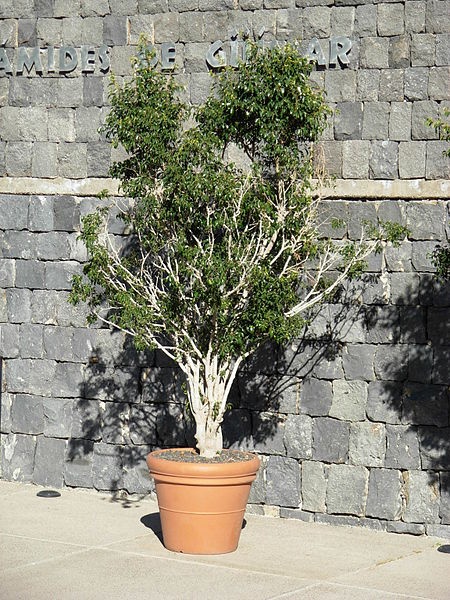 Learn how to prune crepe myrtle to keep your trees looking their best.
Learn how to prune crepe myrtle to keep your trees looking their best.
8. Bay tree
(Image credit: Brent Darby)
As well as creating a sculptural feature, bay trees are aromatic herbs that have wonderfully scented leaves that can be used in cooking fresh or dried.
Bay trees look particularly stunning in pairs flanking a doorway, or can be positioned next to seating areas on the patio for outdoor dining ideas. They thrive in containers and can be clipped into attractive ball or pyramid topiary shapes.
‘A bay tree is very easy to look after, provided you give it a good sunny spot and feed it regularly,’ says Bertelsen. ‘Prune every spring, both to keep it at the size you want it and to reduce any congestion.’
It’s a good idea to repot bay trees every few years to keep them healthy and encourage fresh growth. Bay trees are an excellent choice for planter box ideas.
9. Banana tree
(Image credit: Oleksandr Sokolenko / Alamy Stock Photo)
Banana trees are some of the best trees to grow in pots if you want to add a tropical garden idea to your patio.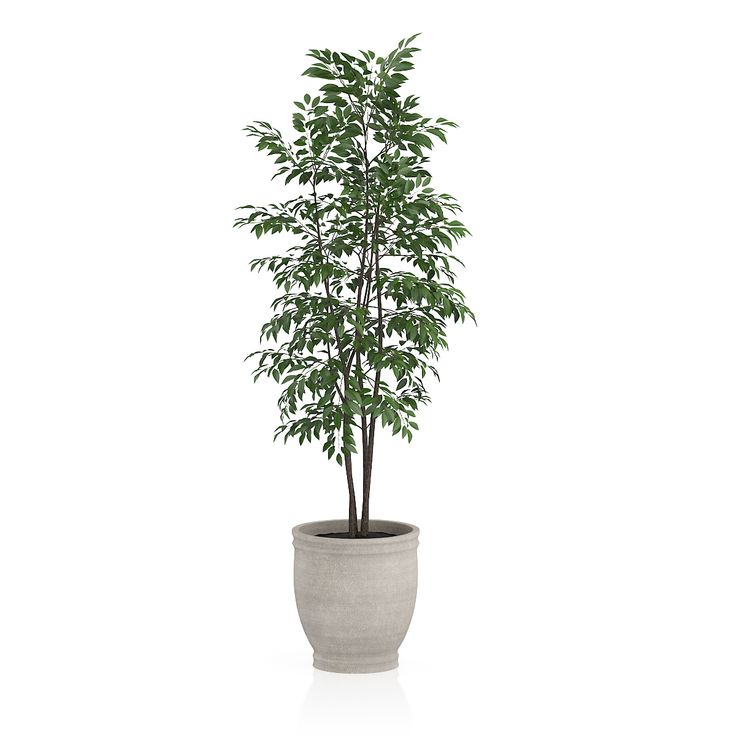 But bear in mind if you are growing a banana tree in the garden this will generally be for their ornamental leaves, rather than for fruit, unless you live in a climate of at least 60ºF (15°C) for most of the year.
But bear in mind if you are growing a banana tree in the garden this will generally be for their ornamental leaves, rather than for fruit, unless you live in a climate of at least 60ºF (15°C) for most of the year.
‘If you live in a cooler climate, then a banana tree still brings a taste of tropics to your landscaping,’ says Tadewaldt. ‘The growth of these trees is usually stunted by the colder weather enough that they can live in the pot for an extended period of time.'
Smaller varieties of banana tree are particularly well suited to climates with colder winters, as they can be brought inside and enjoyed as a houseplant.
10. Rhododendron
(Image credit: Gina Kelly / Alamy Stock Photo)
As well as the popular shrubs, rhododendrons are also available in tree form – R. arboreum. Although after several decades they can eventually reach great heights of over 40 feet, they are slow-growing trees that will live happily for years in a pot, so it is worth learning how to grow rhododendrons.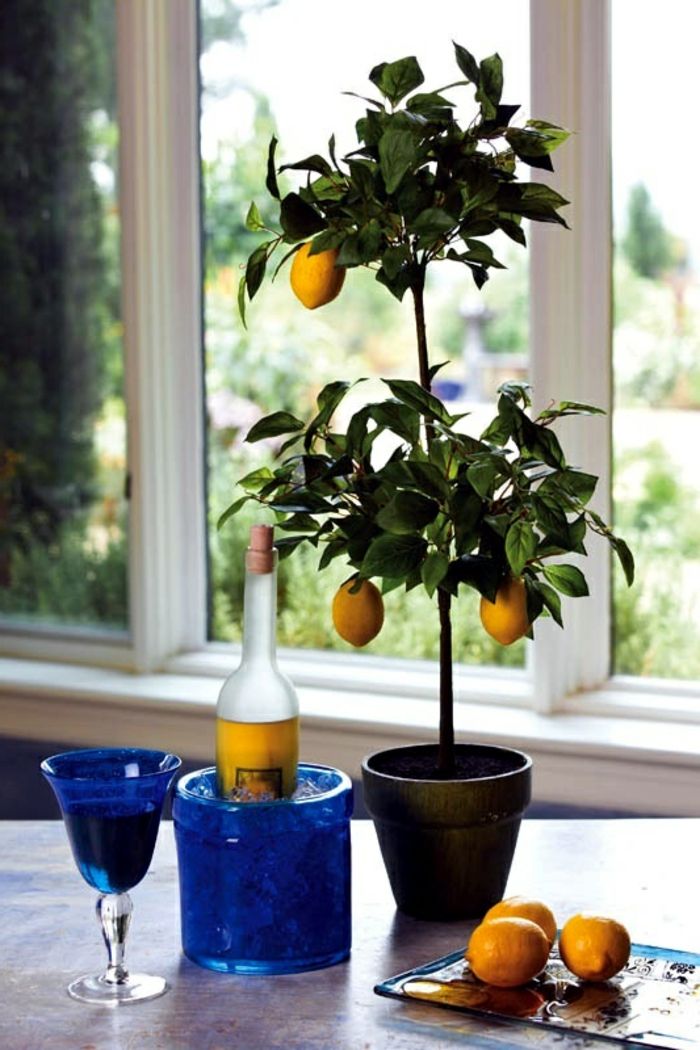
‘I really like rhododendron – it is such a pretty flowering tree with red and white flowers in the summer,’ says Hyland. As an evergreen tree, it possesses attractive dark green leaves year round.
‘My favorite thing about it is its ability to thrive in stunted, acidic, or shallow soil conditions.’
Be sure you know how to prune rhododendron to keep your potted specimens under control.
11. Olive tree
(Image credit: Darren Chung)
If you want to create a Mediterranean garden, olive trees are ideal and perfectly suited to growing in containers, as they can be moved to safety during excessively cold winters.
‘Olive trees are not fond of winter, so make sure to cover them if you know a frost is coming,’ says Barbosa Fernandes.
‘They love warmth and sun, and they also do well in dry areas. However, they do need the right conditions to produce olives.’
In order for the trees to fruit, they will need two months with temperatures below 50°F (10°C), but above 14°F (-10°C), as well as fluctuation between day and night temperatures.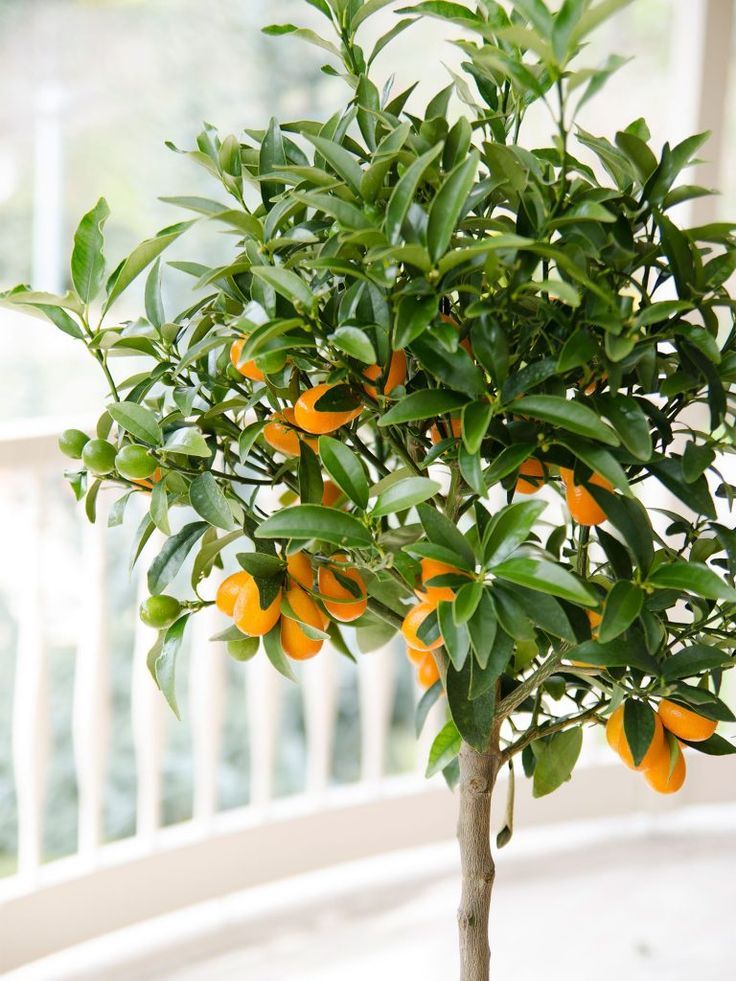 Although self-fertile, olive trees benefit from cross pollination.
Although self-fertile, olive trees benefit from cross pollination.
‘If you don’t have the right conditions to grow olives, don’t be too disappointed, as they’re such elegant evergreen trees,’ says Barbosa Fernandes. ‘Fertilize them in the spring for the best results.’
You also need to know how to prune olive trees to improve their shape and increase the chances of fruit production.
12. Wedding Cake Tree
(Image credit: Steffen Hauser / Botanikfoto / Alamy Stock Photo)
Also known as Cornus controversa 'Variegata', the wedding cake tree is a variegated dogwood tree.
‘The white in the leaves adds interest and it naturally grows in layers – like the layers of a cake, hence its name – and pruning will help to emphasize this form,’ says Tadewaldt.
However, regular pruning isn’t essential, and as the tree is slow-growing, it will live happily in its pot for a long time, as long as the soil is fertile.
‘Eventually, however, this tree will outgrow the pot and need to be transplanted,’ adds Tadewaldt.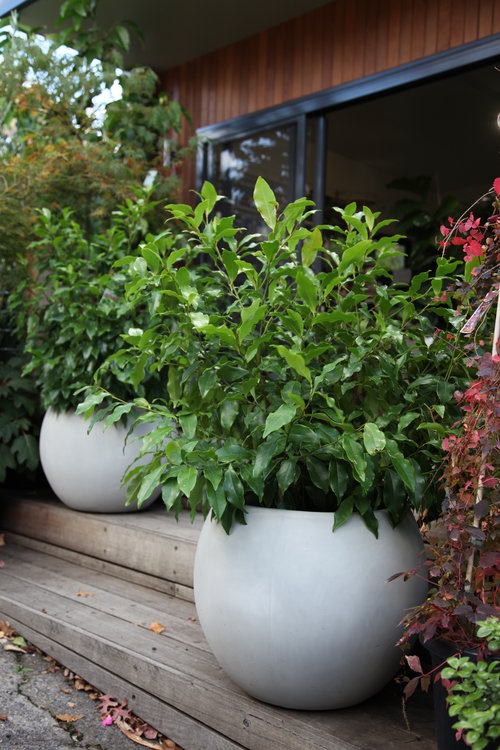
13. Apple tree
(Image credit: Unsplash)
Smaller varieties of apple tree are perfect for growing in pots on the patio. Not only are varieties grown on dwarf rootstock usually quicker to fruit, but they are often better quality than larger trees.
When choosing a variety of apple tree, you need to consider pollination. ‘Self-fertile cultivars are available, although it’s generally recommended to have at least two different partner trees nearby for cross-pollination,' explains Period Living’s gardening expert Leigh Clapp.
When planting apple trees in pairs, 'opt for different varieties of apple tree that flower at the same time.'
If you only have room for one apple tree, Red Falstaff is a great choice as it is heavy cropping and very hardy. Apples trees are among the best fast growing fruit trees so you will enjoy a well sized tree before you know it.
14. Starry magnolia
(Image credit: Getty Images)
While most types of magnolia will grow too large to plant in pots, starry magnolia is a more compact, bushy tree that produces the most beautiful white, star-shaped flowers.
The tree flowers in the spring and exudes a delicate fragrance, adding a romantic air to a patio seating area.
Position starry magnolia in a sheltered spot, and plant in neutral to acid soil that is well drained.
When established, they are low maintenance, and require only mulching in spring, and learn how to prune a magnolia tree lightly in the summer.
15. Kumquat
(Image credit: Francesco Maltinti / Alamy Stock Photo)
Citrus trees make for some of the best indoor trees, but you can grow them outside in the right climates.
‘If you’ve never tried kumquat, then you most definitely should – you can eat the entire thing, skin and all,’ says Barbosa Fernandes.
Producing small orange fruits and flowers that bloom in the summer, these compact trees can be easily grown in pots, and are one of the hardiest citrus fruits.
‘Position them in full sun, and plant in moist, well-draining soil. However, you don’t need to worry about cross-pollination or cold weather killing it down to 18°F (-8°C),’ adds Barbosa Fernandes.
What trees can remain in pots?
Trees can remain in pots indefinitely if you can find a container large enough to accommodate their maximum mature size. Otherwise, you will need to plant them in the ground when they grow too large.
Opt for dwarf varieties of container-friendly trees, such as Japanese maples and small conifers. Bay trees, small citrus trees and olive trees are also good options.
Bear in mind that most trees will need potting on to a larger container every few years, when they have outgrown their pot.
(Image credit: Darren Chung)
Can trees survive in pots over winter?
Some trees can survive in pots over winter, but this will largely depend on your local climate.
In warmer regions, for example, citrus trees can stay outside year round, but in regions that experience cold winter nights of below 50°F (10°C), they will need to be brought inside.
Japanese maple trees are excellent choices for pots in most climates, and can survive very cold winters where temperatures reach as low as -20°F (-28°C).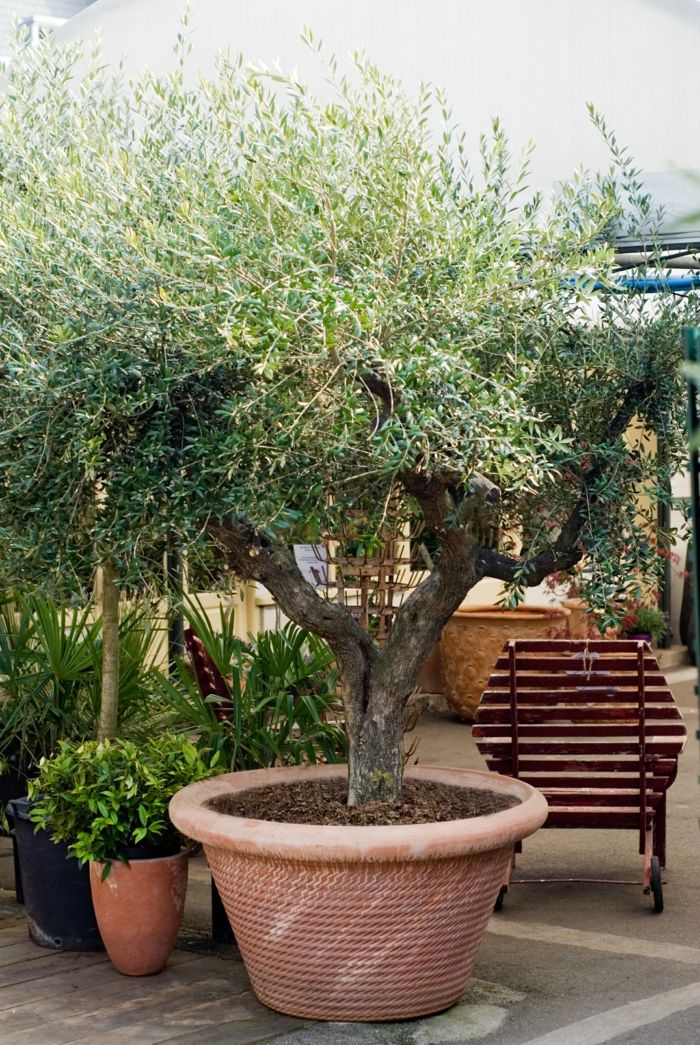
What are the best evergreen trees for pots?
There are a number of best evergreen trees for pots. These include Rhododendron arboreum, bay trees, conifers, Japanese holly and Italian cypress – to name but a few. There are many other options you can find to suit the conditions in your garden and area where you live.
As editor of Period Living, Britain's best-selling period homes magazine, Melanie loves the charm of older properties. I live in a rural village just outside the Cotswolds in England, so am lucky to be surrounded by beautiful homes and countryside, where I enjoy exploring. Having worked in the industry for almost two decades, Melanie is interested in all aspects of homes and gardens. Her previous roles include working on Real Homes and Homebuilding & Renovating, and she has also contributed to Gardening Etc. She has an English degree and has also studied interior design. Melanie frequently writes for Homes & Gardens about property restoration and gardening.
The 10 most popular house trees for houses and apartments
The conditions of a modern metropolis do not allow you to get out into nature often. By surrounding yourself with house trees, you can create an indoor-type oasis. They will become an excellent decoration of the home and create comfortable conditions in it.
Contents
- The most popular living trees growing at home or in an apartment in a pot
- Coffee tree
- Monstera
- Bonsai
- Lemon
- Chinese rose
- Ficus
- Lavr
- Mandarin
- bottle
- Snake
Home living trees, unlike other room colors, have a central barrel and branches . Some of them bloom at home, in other versions - the tree has a lush crown. Thanks to pruning, they can be shaped. The most popular is to create Bonsai from them. Pets perform a decorative function and, in addition, freshen the air .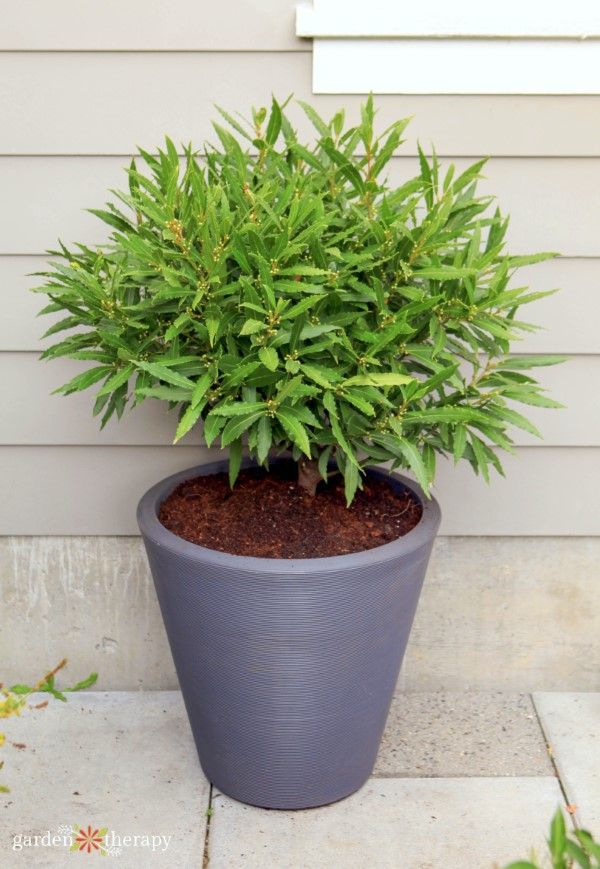
They are used for landscaping apartments, offices and commercial premises. Large, beautifully flowering, and deciduous trees can be of very different shapes. They also differ in the shape and color of the leaves. Features of the most popular types that grow in flower pots will turn the room into a flowering garden.
Coffee tree
A unique plant with beautiful foliage. At home, it blooms and pleases all year round with its greenery. In place of inflorescences, berries are later formed. The leaves are dense, shiny and embossed.
Coffee treeWith proper care, its height can reach 1 meter . The crown is formed by pinching. It tolerates drought well, it is recommended to wipe the leaves with a damp cloth.
Additional lighting is required in winter.
Monstera
Monstera is an indoor flower often found in apartments. Mature tree rather tall and spreading . The leaves are large, with symmetrical slits.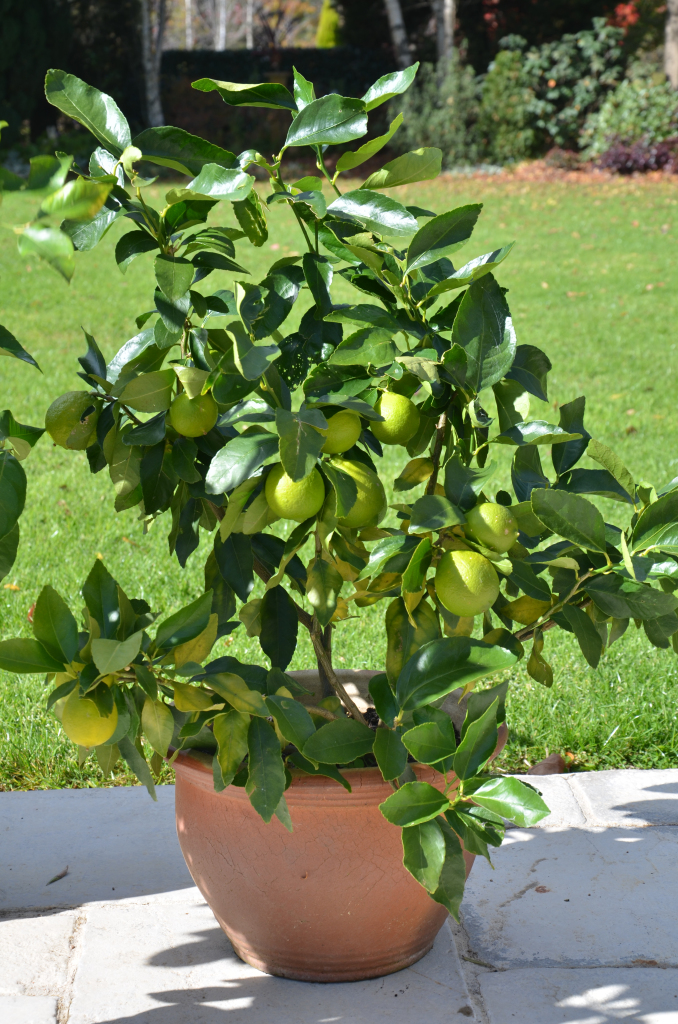 The color of the leaves is bright green, shiny. The monstera leaf is dark green and shiny. In the lower part, aerial roots form over time. You do not need to remove them, they provide the plant with support and additional nutrition. Blooms rarely, white inflorescences.
The color of the leaves is bright green, shiny. The monstera leaf is dark green and shiny. In the lower part, aerial roots form over time. You do not need to remove them, they provide the plant with support and additional nutrition. Blooms rarely, white inflorescences.
Monstera is suitable for large rooms. The height of can reach 3-5 meters .
- Monstera
- monstera flower
Bonsai
Propagation of indoor tree in a flat pot, got its existence in China, later in the West and Japan. The creation of Bonsai has become a whole science. A miniature copy of a tree with a powerful crown has its own characteristics.
- bonsai is considered to be indoor plant with a strong stem and well-developed root system ;
- Branches must be well defined and may be curved;
- the trunk should not be hidden in the foliage; its ratio is minimized;
- the pot is used flat, often clay, inconspicuous color.
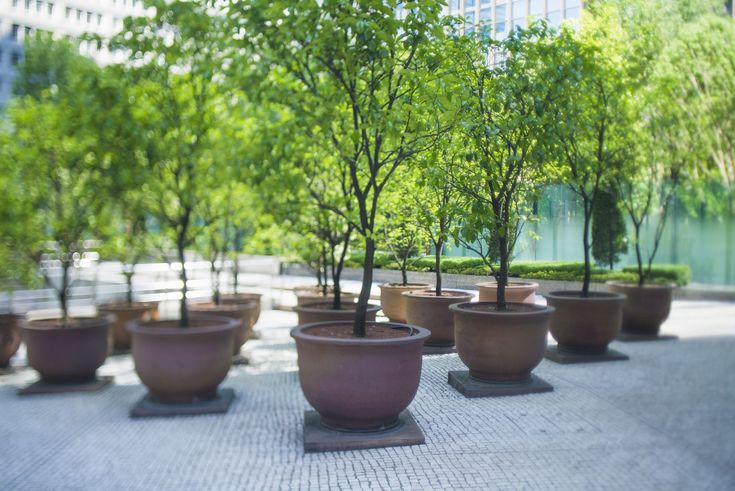
- ficus bonsai
- from pine
- from oak
Florists categorize bonsai according to size and shape. Care requires some knowledge of the characteristics of this species.
To prevent the branches of the bonsai from stretching towards the sun in one direction, it is recommended to unfold the pot.
Lemon
An exotic indoor plant that is not only beautiful, but also useful. With proper care, bears fruit all year round . There are many varieties, among themselves they differ in tree height, leaf shape and fruits.
Productivity is maintained up to 20 years . The leaves are bright green, dense. They are used to make tea. Thanks to its unique features, lemon helps to purify the air.
He is afraid of drafts, if he is comfortable in one place, it is unnecessary to rearrange it once again.
Lemon treeChina rose
Beautifully blooming rose can grow to gigantic size .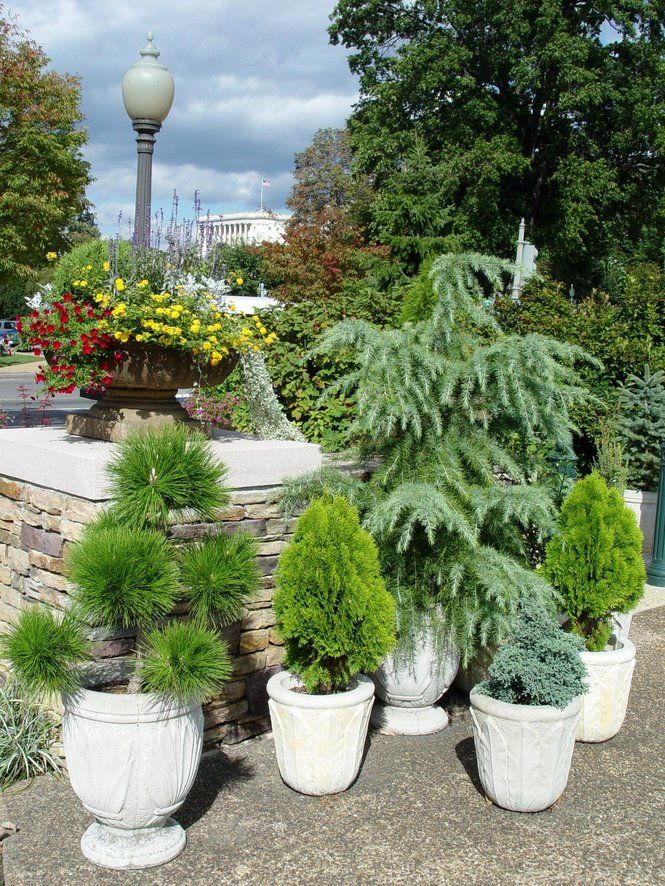 The trunk is woody, the older the flower, the stronger the crown grows. The shape can be corrected by cropping. It blooms in large inflorescences of scarlet color. Scientifically called hibiscus.
The trunk is woody, the older the flower, the stronger the crown grows. The shape can be corrected by cropping. It blooms in large inflorescences of scarlet color. Scientifically called hibiscus.
Suitable for indoor and greenhouse cultivation. Propagated by seeds, division of the bush, layering and cuttings. It is not whimsical in care, it will decorate any room with its presence.
- hibiscus flower
- Chinese rose can grow very large.
Ficus
Evergreen tree can be found in warm Asian countries. We grow it at home. The leaves are dense, oval in shape. The color of the leaves is green or bicolor.
Rare blooms unsightly inflorescences. Florists use different types of ficuses to create bonsai. The height of an adult flower can be 3-5 meters. Propagated by cuttings. It is recommended to fertilize 2-3 times a month. With improper care, leaves can completely fall off.
Ficuses do not tolerate dry air and drought, they need regular watering and daily spraying of leaves.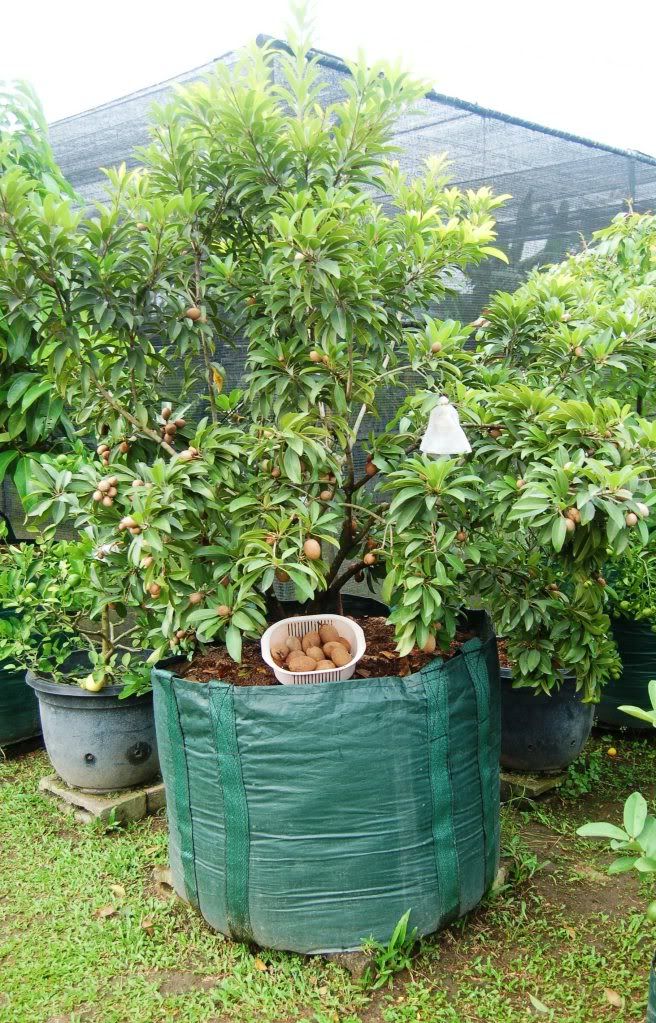
- ficus benjamina
- Robusta
- Microcarp
Laurel
In ancient times, laurel was considered sacred. Today, Europeans use an evergreen plant in the design of landscape designs. A noble tree with fragrant leaves, often grown in kitchens to use as seasoning .
- dense dark green leaves;
- bush grows slowly, is not afraid of pruning;
- laurel loves bright and spacious rooms;
- after flowering, seeds are formed in place of inflorescences.
An unpretentious indoor flower will not cause much trouble, it will become a worthy decoration of the interior. For the summer period, pots with laurel can be taken out to the balcony or loggia.
LaurelTangerine
Sunny and elegant tangerine tree, will become a bright element of landscape design. The plant secretes special substances that enrich the air .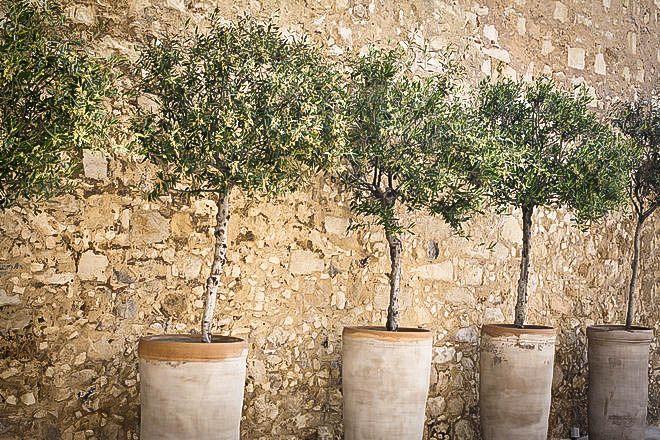
Mandarin repels insects and gives good yields of fragrant fruits. On the windows you can often find dwarf varieties of mandarin. The leaves are dense, green. The trunk is woody. It blooms with small flowers, in place of which green tangerines are formed. When ripe, the fruits turn orange.
Variety susceptible to diseases and pests. The condition of the flower should be monitored regularly. It is impossible to spray with poisons; it is better to use an aqueous solution with laundry soap.
Mandarin treeBottle tree
Bottle-shaped tree found naturally in Mexico and the USA. The scientific name is nolina, bokarneya. The leaves are palm-shaped, thin with pointed edges. Grow in small pots.
The plant loves the sun, is not afraid of drought, but still requires regular spraying. Grows slowly to get a large trunk, it will take 6-8 years . If you water it abundantly, the trunk will quickly stretch upwards, so you need to organize drought conditions.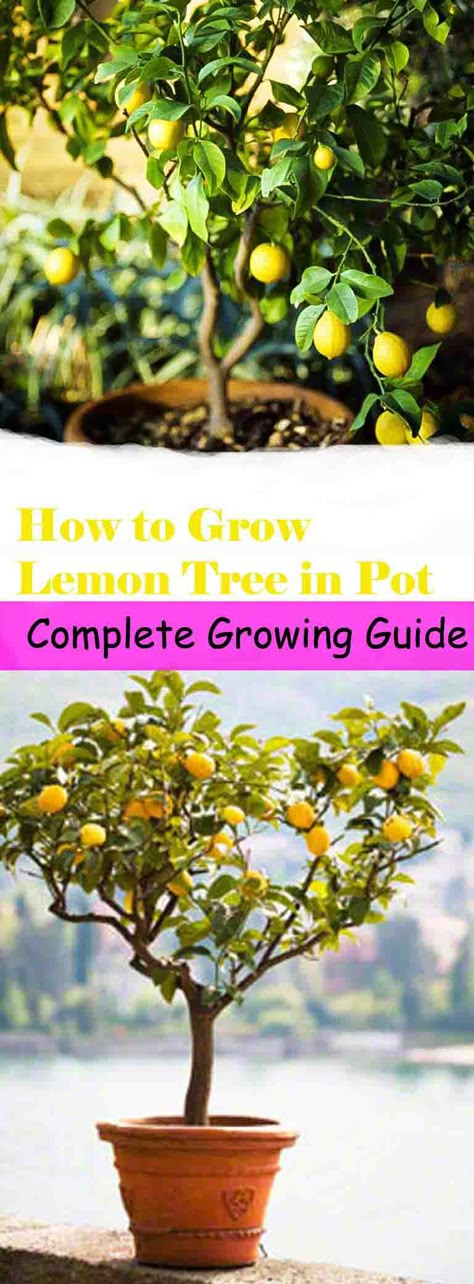
Serpentine
A real miracle, rarely does anyone manage to grow it properly to enjoy flowering. The flowering period begins after 5-6 years . Up to this point, the plant resembles a snake. Later rushes up, forms a tree. The buds look bewitchingly beautiful, but at the same time, emit a sickening smell . Those who decide to place it in a residential area must take this fact into account.
- Snake tree flower has an unpleasant odor
- snake tree
Growing compact trees at home, do not forget - this is painstaking work. It will take several years to get an original bonsai. You can buy a ready-made tree or get hold of cuttings from friends. There are no special difficulties in care, you just need to take into account their features.
8 trees that can be grown at home, on a balcony or terrace
Any plants, be it a banana tree in a pot or a ficus in a pot at home, serve one purpose - to make the interior more natural and natural.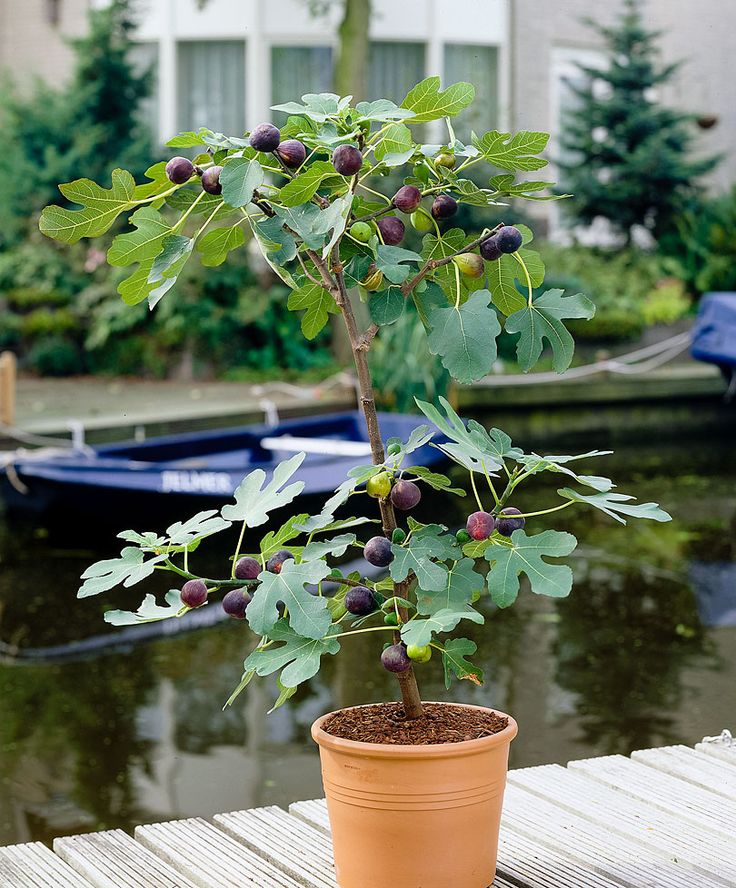 Along with aesthetic accents, many plants disinfect the air, are antiseptic or medicinal, and they can also be added to food.
Along with aesthetic accents, many plants disinfect the air, are antiseptic or medicinal, and they can also be added to food.
1 Laurel
Bay tree can be grown indoors or outdoors. It has a clear geometric shape and can become an architectural accent in a room. In nature, laurel lives for more than a hundred years and blooms regularly in spring. Indoors, the tree may not bloom at all, and life expectancy is reduced to 15 years. The ideal place for such a tree is well warmed up, but without direct sunlight. Moderate watering is needed: like most plants, the bay tree is afraid of too moist or overdried soil.
Instagram @rastenie_store
Instagram @ssvetlana70
Instagram @ssvetlana70
2 Fig
Its birthplace is subtropics, but despite this, the tree feels great both in gardens of the middle lane and in apartments. Moreover, it regularly bears fruit in an apartment up to twice a year, and the fruits are not inferior in taste to those grown outdoors. Feels great in a well-lit place in direct sunlight. The tree should be watered once a week. It is best to determine the right moment by the condition of the soil: as soon as it is dry, wait a day and start watering.
Feels great in a well-lit place in direct sunlight. The tree should be watered once a week. It is best to determine the right moment by the condition of the soil: as soon as it is dry, wait a day and start watering.
Instagram @historical_greenhouse
Instagram @historical_greenhouse
3 Money tree
A thick tree trunk with many branches and spreading leaves looks incredibly attractive both in the interior of an apartment and on a balcony or terrace. The plant does not need serious care: make sure that it does not stand under the scorching sun, and water it once a week. It feels best in a humid environment, so if your apartment has too dry air, sometimes irrigate the leaves with a spray bottle.
Instagram @bonsaikiev
Instagram @bonsaikiev
4 Olive tree
Needless to say, olive is a must-have for Mediterranean-style interiors.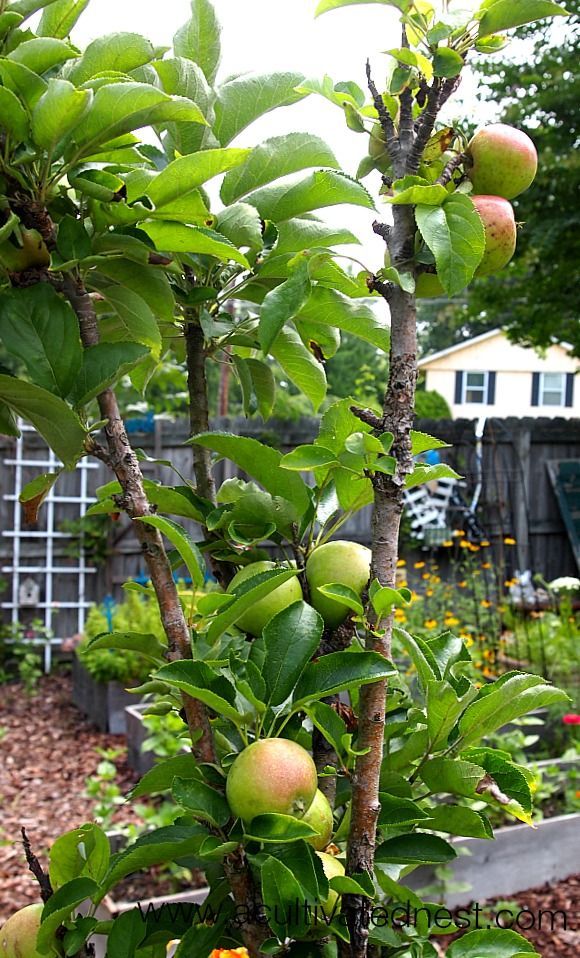 The plant looks elegant and does not require serious care. Feels good in a lit sunny place. Water it as the soil dries out. The olive tree will only bear fruit if cross-pollinated, but even without this, the tree looks very aesthetically pleasing in the interior.
The plant looks elegant and does not require serious care. Feels good in a lit sunny place. Water it as the soil dries out. The olive tree will only bear fruit if cross-pollinated, but even without this, the tree looks very aesthetically pleasing in the interior.
Instagram @luxuryplants.ru
Instagram @luxuryplants.ru
5 Ficus
No list of plants for a home or terrace is complete without ficus. This is a versatile plant for any interior that looks attractive and does not cause much trouble with care. Place the ficus planter in a well-lit space, but not in the scorching sun. Water more frequently in summer, and reduce watering in winter. In any case, you should focus on the soil: if it is wet, you don’t need to water it, humidify the air in the room or irrigate the leaves.
Instagram @scandi_view
Instagram @scandi_view
Instagram @scandi_view
6 Citrus trees
Despite the fact that you should not expect a full-fledged harvest from indoor citrus trees, a compact tree with small bright fruits can decorate the interior of a room or balcony.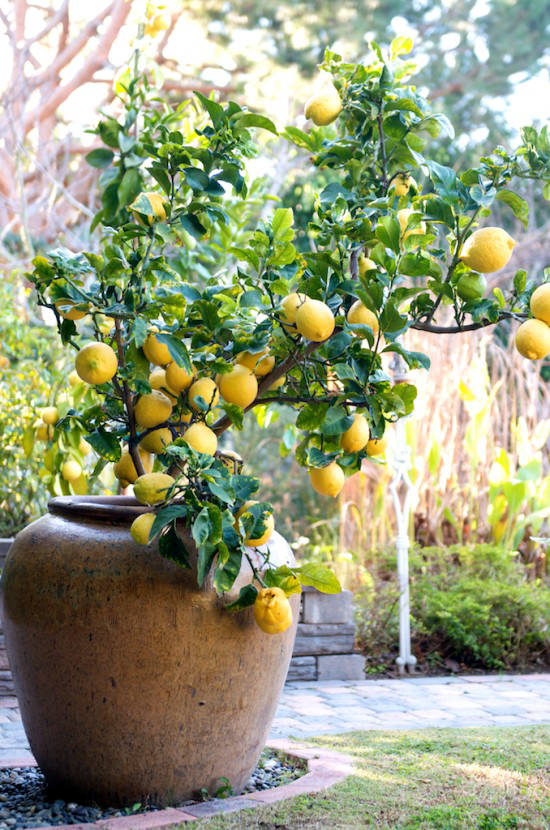 For good health, he needs a lot of light and moisture. But do not fill the pot, otherwise the root system may begin to rot and the plant will die.
For good health, he needs a lot of light and moisture. But do not fill the pot, otherwise the root system may begin to rot and the plant will die.
Instagram @oksanaryapenko
Instagram @oksanaryapenko
7 Coffee
It is not difficult to grow a coffee tree, it can be done even from green beans. What's more, most coffee trees produce excellent fruit at home, and you can periodically enjoy a cup of coffee grown by yourself in the morning. It is best to place the coffee tree in full sun and water frequently. But be careful with the movement of the planter: the peculiarity of the plant is such that it can stop growing even with a slight change in location.
Instagram @bloom_story_ru
Instagram @zantseva_svetlana777
8 Tree-like dracaena
This is a fairly tall tree: up to three meters with a shock of tousled leaves at the ends of branches.

